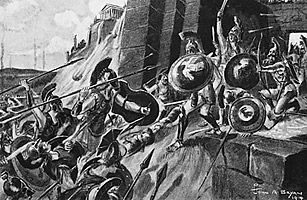
In his first State of the Union address, President Obama declared that he would work to “finally repeal the law that denies gay Americans the right to serve the country they love because of who they are.” Though a June 2009 Gallup poll showed that 69% of Americans support allowing gays and lesbians to serve in the military, repealing “Don’t ask, don’t tell” will take more than a declaration — it will take an act of Congress. Defense Secretary Robert Gates and Admiral Mike Mullen, the chairman of the Joint Chiefs of Staff, are presenting a proposal to repeal the ban in the first congressional hearing on the issue in 17 years. According to a Jan. 26 study by the Williams Institute at UCLA’s School of Law, there are an estimated 66,000 lesbians, gays and bisexuals currently serving in the U.S. armed forces; for these soldiers, progress on a repeal is only the latest glimmer of hope in a long history of secrets.
For the ancient Greeks, gays serving in the military were no big deal. Indeed, Plato wrote in his Symposium that a small army composed of lovers and those they loved would be more than a match for much larger armies: “For love will convert the veriest coward into an inspired hero.” But for the most part, that’s where support of gays in the military ended.
Following the Crusades, the Knights Templar were persecuted and many members burned at the stake for their same-sex affairs in the early 14th century. In the Napoleonic wars, four men aboard the British ship H.M.S. Africaine were hanged in 1816 for “buggery”; two other crewmen were whipped for “uncleanness” . Even General George Washington discharged an American soldier in 1778 for participating in homosexual acts.
Though the U.S. military explicitly prohibited homosexuality in the Articles of War of 1916, a ban wasn’t enforced until World War II. Amid the largest mobilization in U.S. history, the Army, Navy and Selective Service System developed procedures for spotting and excluding homosexual draftees from service: recruits were screened for feminine body characteristics, effeminacy in dress and manner and a patulous rectum. By war’s end, more than 4,000 of the 12 million men conscripted for the war effort were rejected for being gay. During Vietnam, homosexuality or the appearance of it was seen by some as a way to avoid service in a bloody and unpalatable conflict, although it didn’t always work: in 1968 Perry Watkins, a 19-year-old from Washington, was drafted despite checking the “yes” box in the category “homosexual tendencies” during his preinduction physical examination. After 16 years of service, the military discharged Watkins for his sexual orientation in 1984; he promptly filed a lawsuit and went on to win his case in 1990.
Enter “Don’t ask, don’t tell.” During his 1992 presidential campaign, Arkansas Governor Bill Clinton promised to lift the ban on gays in the military — a move opposed by senior military officials and a majority of the American public. It became one of the first issues Clinton tackled as President, but when the White House attempt to unilaterally repeal the ban stumbled, Congress passed a law to keep openly gay men and women from serving. Gays were allowed to serve so long as they kept quiet about their sexual orientation. The phrase “Don’t ask, don’t tell” doesn’t completely describe the law, formally known as the Military Personnel Eligibility Act of 1993. While the Pentagon agreed to stop asking about sexuality in recruitment forms and interviews, it never agreed to stop investigating whether those serving in the military were gay. As a result, since 1994, more than 12,000 servicemembers have been dismissed because of their sexual orientation.
Today, 25 countries allow gays to openly serve in their armed forces, including the U.S.’s closest neighbor, Canada. The British military began allowing gays to serve in 2000; members of the Ministry of Defense told The New York Times in 2007 that there had been no reported incidents of harassment, discord, blackmail or bullying, nor any erosion of unit cohesion or military effectiveness. In Israel, which has had no restrictions on gays serving in the military since 1993, the army magazine, Bamahane, showcased two men hugging each other on a 2009 cover. In Russia, people “who have problems with their identity and sexual preferences,” as the military guidelines put it, are allowed to serve only during times of war. Many other countries ban homosexuality in society in general, making gays’ military service there a nonissue. In the U.S., however, many think it’s time for the military to catch up with the times. “As a nation built on the principle of equality,” wrote General John Shalikashvili, former chairman of the Joint Chiefs of Staff, in a letter to Pentagon leadership, “we should recognize and welcome change that will build a stronger, more cohesive military.”
Read “Arguing About Gays in the Military: It’s So Over.”
Read “Gays in the Military: Does a Sailor’s Murder Signal Deeper Problems?”
Watch a gay-wedding video.